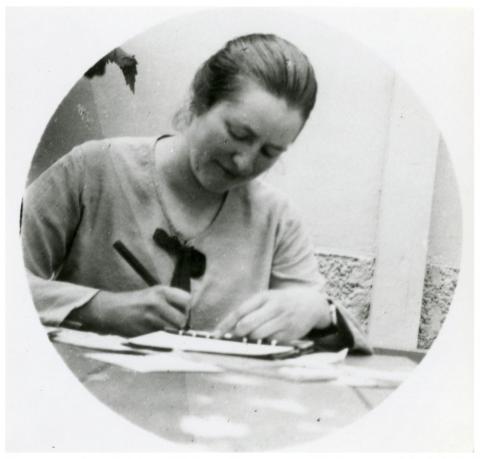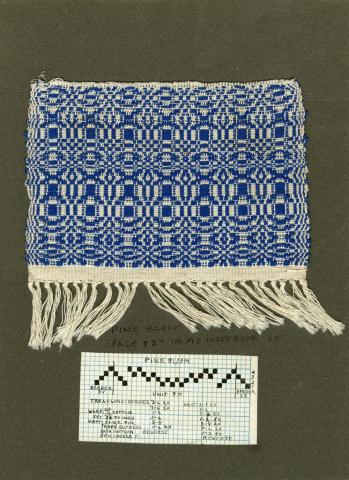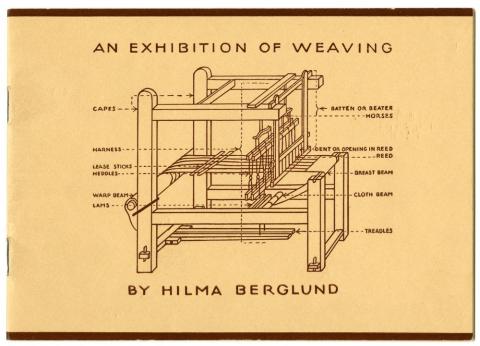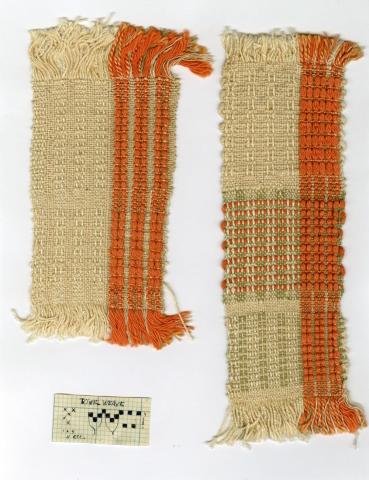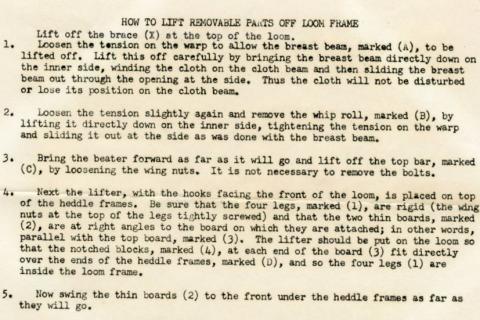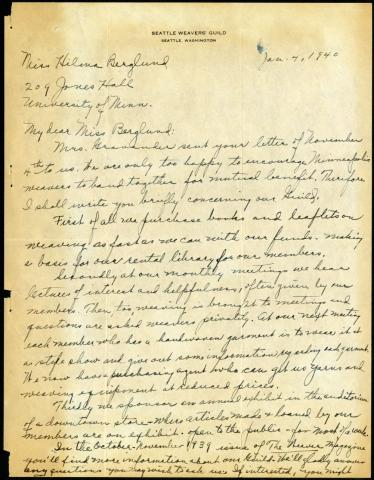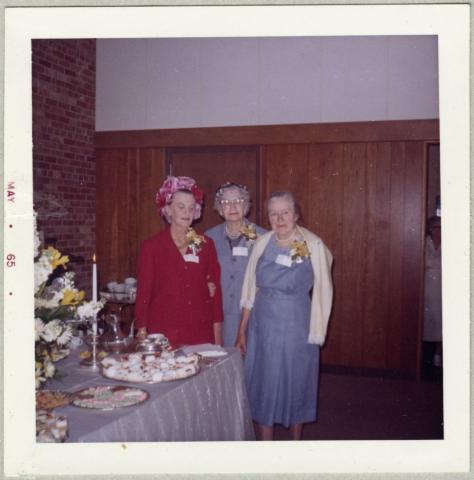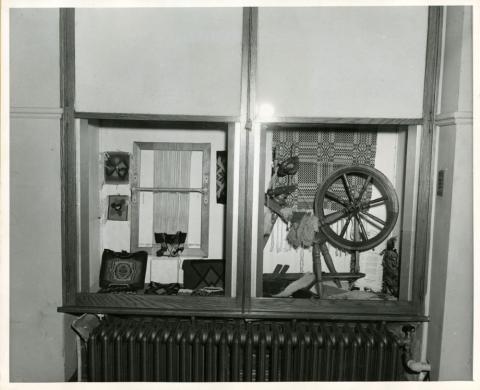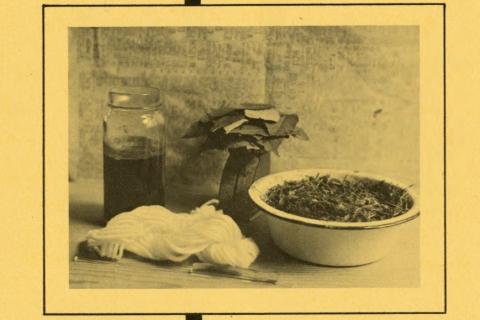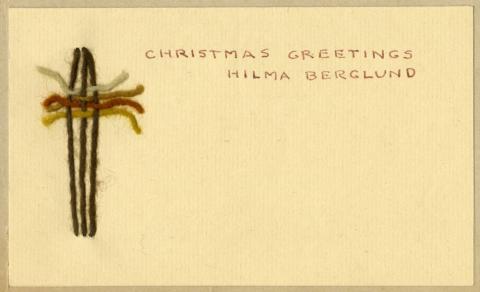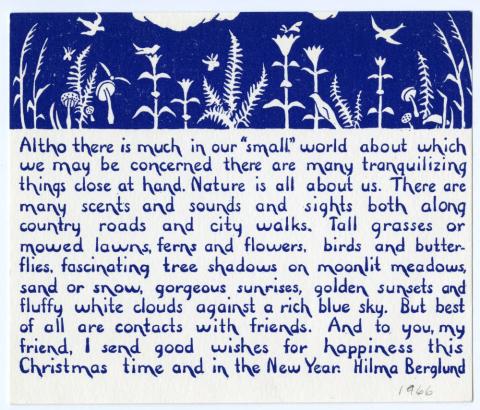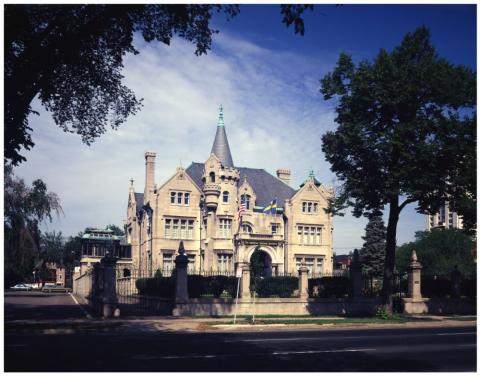Primary Source Set
by Grace Onsrud, Minnesota Digital Library Volunteer
Arts and Literature People of Minnesota
Hilma Berglund (1886-1972) was a weaver, teacher, and founding member of the Weavers Guild of Minnesota. She was born in Stillwater, Minnesota to Swedish immigrant parents. Due to frequent illness during her childhood, she was often unable to attend school, and she instead developed an interest in handicrafts such as embroidery and china painting. She found many opportunities to grow her artistic skills as she grew up during the Arts and Crafts movement of the late 19th century, a cultural resurgence in interest in handcrafted goods in response to increasing industrialization and mass production.
Berglund took many art classes, including at the St. Paul Institute of Art and the Minneapolis Handicraft Guild, where she later taught. Her interest in weaving began with a trip to Stockholm, Sweden to study traditional Swedish weaving patterns.
She entered the University of Minnesota as an undergraduate student in 1926 and later became an instructor there, teaching weaving classes to occupational therapy students. She also earned her master’s degree from the University of Minnesota in 1939. She noticed a high demand for looms while teaching her classes, so she designed a new kind of loom with removable pieces, allowing multiple students to use it. She called it the Minnesota Loom.
In 1940, Berglund helped gather a group of weavers who formed the Twin Cities Weavers Guild, now the Weavers Guild of Minnesota. She was the first President. In its early years, the Guild focused on practical kinds of weaving such as making aprons and skirts. Today, the Weavers Guild works to preserve and advance weaving, spinning, and dyeing as art forms.
In addition to her work with the Weavers Guild and the University of Minnesota, Berglund also gave many talks and demonstrations at the American Swedish Institute, an arts and cultural organization in Minneapolis, Minnesota. Berglund’s interest in weaving led her to travel around the United States and to China and Japan to study textile arts in other communities and cultures. She also enjoyed making illustrated Christmas cards, exploring natural dyeing techniques, and spending time at her cabin near Pine City, Minnesota.
Discussion Questions & Activities
- One of the primary sources in this set is a letter to Hilma Berglund from a member of the Seattle Weavers' Guild encouraging Berglund to form a guild in Minnesota for weavers to share resources and ideas. What are the benefits of building a community around a shared interest?
- In its early years the Weavers Guild of Minnesota focused mainly on weaving for practical purposes, but it now also promotes and explores weaving as an art form. Textile arts such as weaving have been devalued and dismissed as women's work, and were historically considered "crafts" rather than fine arts. Craft refers to the creation of objects that serve a practical purpose, while art objects are created to express ideas or emotions. Where do the categories of art and craft overlap? Is the distinction between art and craft important or necessary?
- What is the purpose of creating a weaving swatch?
- As a teacher, Hilma Berglund did not have a "traditional" leadership role, but she still made an impact. Think of the many ways a person can be a leader or have an influence on their community, particularly if they are a minority or are not in a traditional leadership position. How can you be a leader in communities that are important to you?
- Hilma Berglund designed a loom for her students at the University of Minnesota. Try making your own loom out of cardboard. You can reference the guide "Make Your Own Cardboard Loom" listed in the sources below.
eLibrary Minnesota Resources (for Minnesota residents)
"Arts and Crafts movement." Britannica School, Encyclopædia Britannica, 14 Dec. 2021. Accessed 9 Mar. 2024.
"Loom." UXL Encyclopedia of Science, edited by Amy Hackney Blackwell and Elizabeth Manar, 3rd ed., UXL, 2015. Gale In Context: High School. Accessed 9 Mar. 2024.
St Clair, Kassia. "Embarrassment of obscurities: Women, weaving and history." TLS. Times Literary Supplement, no. 6030, 26 Oct. 2018, pp. 24+. Gale In Context: High School. Accessed 13 Mar. 2024.
Additional Resources for Research
Archive Record: Hilma Berglund papers. M-0017. American Swedish Institute, Minneapolis, Minnesota. Accesed 15 Mar. 2024.
"Art Term: Craft." Tate. Accessed 15 Mar. 2024.
Cartwright, R. L.. "Handicraft Guild." MNopedia, Minnesota Historical Society.
"From the archives: Hilma Berglund's annual Christmas Cards." Weavers Guild of Minnesota, 4 Dec. 2018. Accessed 9 Mar. 2024.
"History of WGM." Weavers Guild of Minnesota. Accessed 9 Mar. 2024.
"In-depth: A Look at the History of WGM." Weavers Guild of Minnesota, Oct. 9, 2018. Accessed 9 Mar. 2024.
"Make Your Own Cardboard Loom." Asian Art Museum. Accessed 9 Mar. 2024.
"Swen, Tilda, Emil, Hilma, and Raymond Berglund, 1907." Archive Record: Hilma Berglund papers. M-0017. American Swedish Institute, Minneapolis, Minnesota. Accessed 15 Mar. 2024.
"Trip to Europe photograph album, 1914." Archive Record: Hilma Berglund papers. M-0017. American Swedish Institute, Minneapolis, Minnesota. Accessed 15 Mar. 2024.
Published on
Last Updated on
